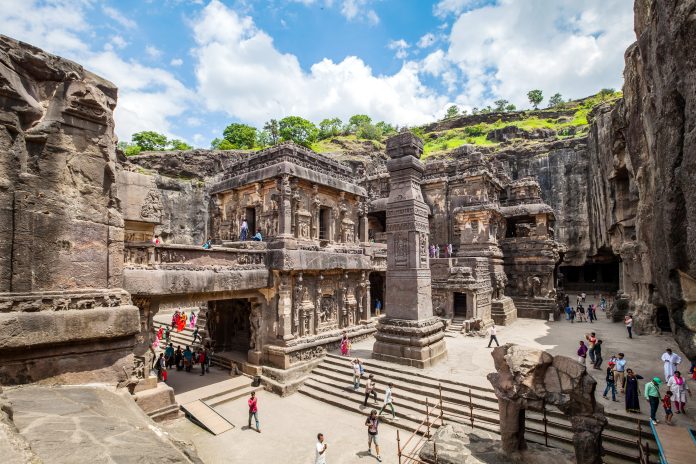By Journey Man
The Kailasa temple of Ellora and its adjacent caves and temples for a World Heritage Site, but technologically it is also a wonder. It has still not been found how such an array of brilliant temples could be carved out of sheer rock, digging downwards.
Ellora is situated about 15 miles north-west of Aurangabad. It is known to the world for its wonderful cave temples in the hills which are about a mile to its east. These cave temples, which were long concealed from view by the engulfing jungle, are now among India’s top tourist destinations that few visitors are likely to skip. They are officially listed on the World Heritage List by UNESCO.
These caves were carved out of the vertical basalt cliffs of the Sahyadri Hills. Out of the 34 rock cut structures that are numbered, Buddhist settlements can be found in caves 1 through 12, Brahminical structures 13 through 29, and Jaina caves 30 through 34. Cave 16 is the Kailasa temple of Ellora, which is the largest monolithic rock structure in the world.
The Kailasa temple is 300 feet long and 175 feet wide, and it is carved out of a scarp that is over 100 feet high. Contrary to many other ancient rock structures, this temple complex was built (carved out) from top to bottom rather than bottom to top. The job was done with no better tools than chisels and hammers. Scaffolds were not used at all. Due to the size of the excavation and the splendour of the design, this cave is an unrivalled masterpiece of Indian architecture.
A common theory is that the Kailasa temple originally had a thick layer of white plaster on it that made it resemble the holy Kailash mountain, hence the name. Scholars do claim that the entire temple was in fact painted and plastered, which is why it was also known as the Rang Mahal, or painted palace. Some fragments of the old fresco paintings can still be seen on the porch roof of the upper temple. However, it’s still not clear how much of the surface was painted white.
Another perspective is to see the Kailasa temple as an allegory of Kailash mountain, which is said to be the abode of Shiva.
It is also said that the magnificent three dimensional sculpture of Ravana Anugraha Murti on the southern side of the main temple might be the reason that the temple was given the name Kailasa. In the murti, Ravana is depicted as multi-armed, shaking Mount Kailash, where Shiva is shown seated in repose. The ego of Ravana is shown being trampled by just the pressure of the toe of Shiva.
HISTORY
While the construction surrounding this magnificent architecture is still a mystery, historians believe that it dates back to 756 to 773 CE and was built by Rachtrakuta king Krishna I. Although, no details about the ruler have been documented anywhere and thus hasn’t been found to date.
However, what is known is the fact that the architecture of the temple which is dedicated to Lord Shiva represents the top of Mount Kailash, the Himalayas which is also considered to be his abode. Not just this, but the method construction of the cave too was something that separates this temple from others.
Kailasa Temple was constructed upside down and since there were no cranes, the army of men with hammers and chisels made their way vertically into 200,000 tonnes of rock. Standing at almost three storeys tall, the main temple complex, Shikhara is a sight to behold. With individual shrines, large statues and free-standing pillars, the artisans added intricate designs and sculpture details as they descended from one storey to another.
Carved from an enormous single rock, The Kailasha has stone carvings that depict various Hindu deities like Lord Shiva (to whom this temple is dedicated), Lord Vishnu and the panels in this temple even show the devotees of these gods. At the base of the temple, one can see the carved elements that appear to carry the load of the temple on their backs.
Kailasa temple: The Architecture
The construction of Kailasa temple as discussed by scholars consisted of excavating out of the hillside three huge trenches at right angles, cut down vertically to the level of the base of the hill. This operation outlined the shape of the courtyard and at the same time left standing in the middle a large isolated mass or “island” of rock, over 200 ft long, 100 ft wide, and 100 ft high at its apex.
According to an architectural calculation, one and-a-half to two million cubic feet of rock was removed by digging these trenches. Since it would be nearly impossible to lift stones out of a trench that deep (without cranes), scholars speculate that they may have chosen the simplest method, which involved having the sculptors chisel the rock from top to bottom so that boulders removed from the area surrounding the main shrine could be rolled down the mountainside by supporting work crews.
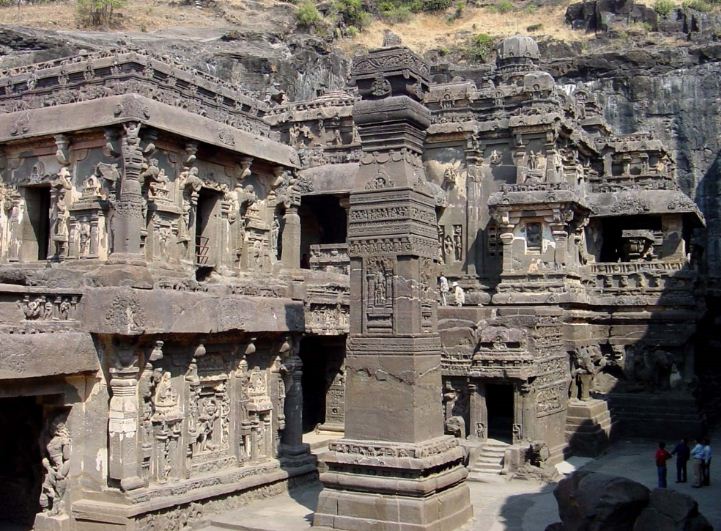

The puzzle remains as to where the many tonnes of the stones that were removed went. Also, the rocks would need to have been discarded somewhere, but one cannot find any evidence of rocks being piled up nearby. We still don’t have any trustworthy sources to talk about where the rocks went or how they were used.
Extraterrestrial theory
According to pseudoscience books, there are countless hidden passageways beneath places like Ellora that once housed energy machines and other ancient technology. It is said these extraterrestrial machines may have been used to build the enormous temple of Kailasa. There are also mainstream discussions about mythological technology that had the ability to vaporise rocks. However, there are no reliable sources supporting any of these hypotheses.
Inside the temple
A two-storey Gopuram is located at the entrance. On the sides of the entrances are sculptures of gods revered by Shaivites and Vaishnavites. Two interior courtyards are visible from the entrance, each bordered by a columned arcade.
Each courtyard in the north and the south has a huge, single rock with a life-size elephant carved into it. The Rashtrakuta kings were known to have won several battles with their elephant brigade, making elephants one of their favourite animals. The presence of elephant sculptures in the temple might have represented the strength and prosperity of Rashtrakuta kings.
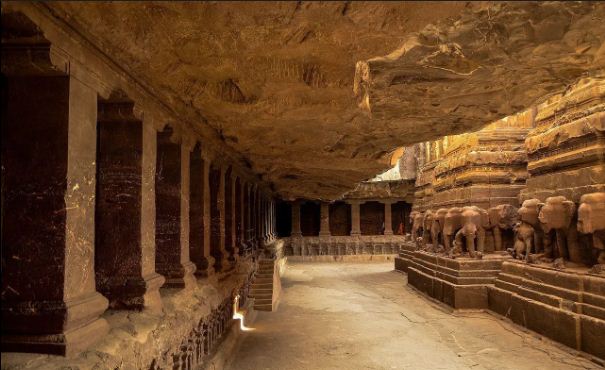

The sikhara (vimana) rises 96 feet above the court beneath it and is octagonal, which is a typical feature of Dravidian architecture. Around the garbhagriha (sanctum sanctorum) is a small antarala (antechamber), which is joined by a large sabha-mandapa (Mandapa is a pillared hall). It has an ardha-mandapa on the sides and an agra-mandapa at the front. The nandi-mandapa is carved in between the gopura and the agra-mandapa of the shrine, and all the three parts are joined by a sort of rock cut bridge.
The adhishtana, or plinth of the main temple, contains a row of enormous, nearly life-size sculptures of elephants that appear to be carrying the entire weight of the structure.
Behind the temple
In addition to its magnificent architectural features, the complex also has cosmological aspects. The architectural design of the temple complex is viewed by some scholars as a journey from the material to the spiritual, from the earthly to the celestial, and from matter to mind.
The Gopuram, or entrance gate, serves as the main point of entry and symbolises the passage from the human world to the sacred. As one moves from one mandapa to the next, the size, volume, and space of the hall get smaller and the light gets dimmer, which signifies that there are fewer distractions and one is getting closer to the sacred world.
The atman, the fundamental components of the human spirit, essence of the individual, the conscious energy, is thought to be independent and complete in itself while also being a component of the brahman, the grand scheme of the cosmos, unchanging universal spirit or consciousness that underlies all things.
Similarly, the elements of Kailasa temple are seen to be complete in themselves and are connected to one another in such a seamless way that they appear to be a single complex. Therefore, the entirety of the Kailasa temple symbolises the brahman and the cosmos, while its individual parts symbolise the atman.
The Kailash temple of Ellora is a place where both architectural genius and the philosophy of spiritualism coexist. There is a consensus that no later Indian dynasty was able to create a structure as majestic as the Kailasa temple in Ellora. The attempt of the Jainas to achieve a similar feat, though on a smaller scale, ended in an incomplete excavation at Cave 30, which earned for itself the name Chhota Kailasa.
Not only was building the temple challenging, but it was also nearly impossible to destroy it. Aurangzeb, the Mughal emperor, once attempted to destroy the temple and put its virtues to the test. Medieval sources assert that as a result, most of the paintings were destroyed and the carvings suffered significant damage. The caves, however, are still standing.
World’s largest monolithic structure
Locally known as ‘Verul Leni’, Ellora Caves are well-known for its largest single monolithic excavation in the world, the great Kailasa Temple. The Great Kailasa is a freestanding, multi-storied temple complex dedicated to Lord Shiva. The speciality of this 1300 year’s old architectural marvel is that it is carved out of a single volcanic basaltic rock of the Charanandri hills and is considered as the largest monolithic piece of art in India as well as in the world.
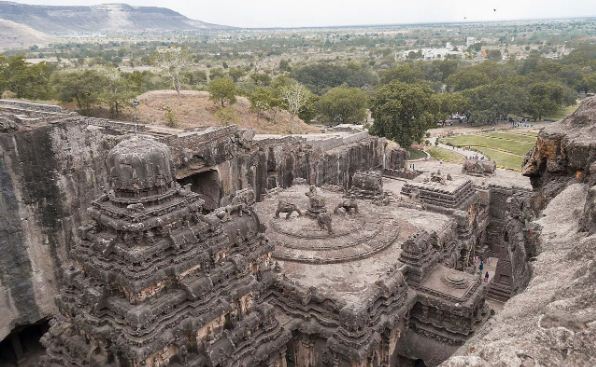

Even the sculptures at this enigmatic temple are carved from the same piece of rock as the rest of the temple. The temple architecture shows traces of Pallava and Chalukya styles. Attracting a huge number of tourists across the globe from centuries, it is one of the must visit places in Ellora during your Aurangabad Tour.
Top to bottom
The architecture of Kailasa Temple is notable for its vertical excavation, the work started at the top and moved downwards, rolling down the large boulders split from the mountain using rod drills. One can see the drill marks on the surrounding walls that are still visible. A megalith carved out of a single rock, the Kailasa Temple is the only structure in the world that is carved from the top to bottom. Every single design and measurement was planned very accurately as once its cut there was no chance to change it by adding any extra stone or piece of rock. Legend has it that nearly 200,000 tonnes of rock was removed to construct this monolithic structure.
Built in 18 years
Constructed by Rashtrakuta king Krishna I in 756-773 CE, the Kailasa Temple, prominent of all the Caves in Ellora, has fascinated researchers and tourists for centuries. Archaeologists had calculated that it would have taken more than a hundred years to finish the temple construction. But, in reality it took only 18 years to complete it. The rock cut temple was cut in U shape about 50 metres in the back, and about 2,00,000 tonnes of rock was scooped out of a vertical basalt cliff in the Charanandri Hills to form the magnificent temple.
Everyone is trying to understand how the temple was built, cut out of the rocks, by using ancient traditional methods without using any modern technology within that short period of time.
Larger in area than Parthenon in Greece
Kailash Temple is considered as one of the most remarkable cave temples in India due to its massive size, architecture and sculptural treatment. About 145 feet wide, 195 feet long and 90 feet high, Kailash Temple covers an area twice the size of the Parthenon in Athens, Greece. With its gigantic sculpted monolithic main shrine in the centre, gopura and enclosure walls on both sides, the Kailash temple is one of the largest structures in India and in the world, rivaling even the Taj Mahal in Agra.
Intricate sculptures and carvings
Almost every inch of the interior structure contains intricate sculptures and carvings in Ellora Caves which display artistic richness and philosophy making the caves a major achievement of ancient Indian civilization. Among the most noteworthy are monolithic elephants and victory pillars at the entrance, the image of Nandi, four sculptures of lions standing in a circle on the roof of Mahamantapa, elephant sculptures at the base of the temple, which gives the viewer an impression that the whole structure is being supported on the backs of these beasts.
Furthermore, various intricately carved panels can be found in the Kailasa Temple like scenes from the two major Hindu epics, the Mahabharata and the Ramayana along with 10 panels depicting the different avatars of the Hindu god Vishnu. The most noteworthy of them is of demon king Ravana attempting to lift Mount Kailasa.
Indestructible
Mughal King Aurangzeb who destroyed thousands of Hindu temples, also tried to destroy Kailasa temple. It is said that 1000 people were sent to destroy the temple in the year 1682. They worked for 3 years but they could break and disfigure a few statues only. Aurangzeb finally gave up on this task and realized that it was impossible to completely destroy the temple as the rock was simply too hard to demolish, even though artisans used only hammers, chisels and picks to construct it.
Where to Stay
Hotel Kailas: Starting price @Rs2599/
Set in serene gardens off National Highway 52, this informal hotel with views of the Ellora Caves temple complex is an 8-minute walk from Kailasa Temple.
Ellora Heritage Resort:Starting price @Rs1459/
Set 1 km from the monumental Ellora monastery-temple cave complex, this modest resort is 29 km from Aurangabad Train Station and 5 km from the scenic Bani Begum Mughal Garden.
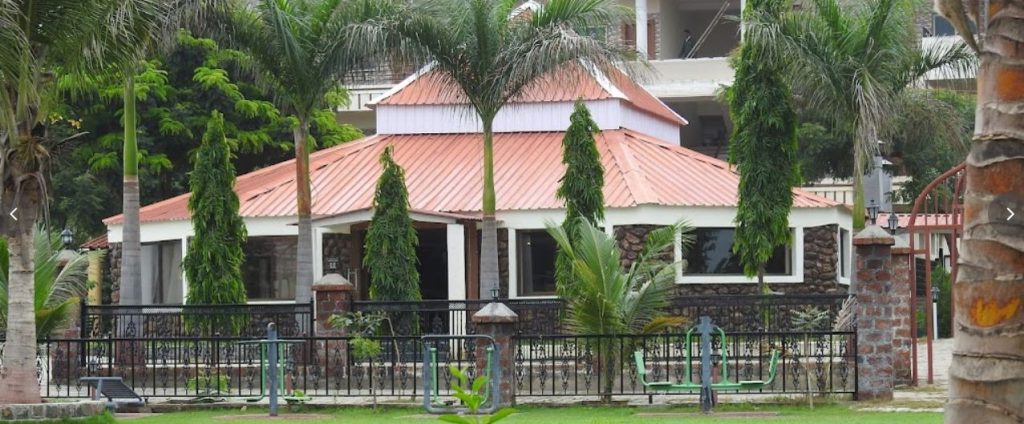

How to Reach :
By Road:
Aurangabad is the nearest city to Kailasa temple and it is well connected with them by road. From Aurangabad bus and taxi services are available to reach Kailasa temple. Aurangabad is also well connected by state transport buses from major cities of Maharashtra like Mumbai, Pune, Nashik, Satara, Kolhapur and Ahmednagar.
By Train:
Aurangabad is the nearest railway station to reach Kailasa temple which is situated around 30 kms from the temple. There are direct trains available from the major cities in Maharashtra; like Mumbai, Pune, Ahmednagar, Nashik etc. to reach Aurangabad.
By Air:
Aurangabad airport is located at about 15 kms from the Kailasa temple and it is the closest airport to the Kailasa temple. Aurangabad airport is well connected to major cities of Maharashtra and India. One may fly to Aurangabad and reach Kailasa temple by any local transport.

